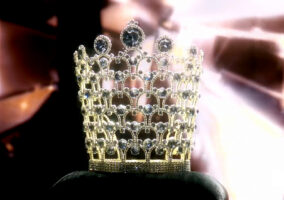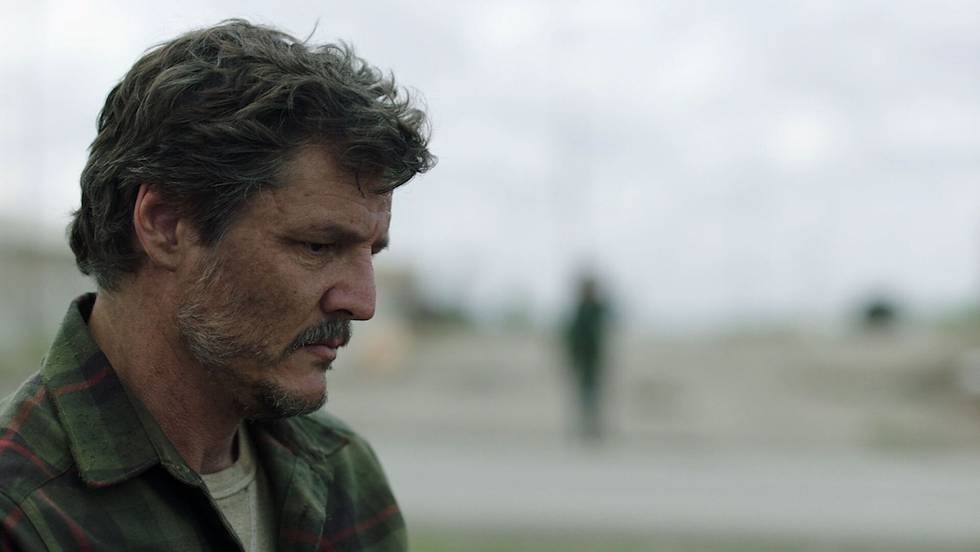
Joel and Ellie make new friends and enemies, the show delivers an astonishing action set piece, and we learn that danger in this world isn’t always a mushroom zombie or a strong man with a gun. It can be a grieving, broken woman who’s really good at rallying desperate people to do her bidding.
We open with the Kansas City rebellion, which is brutal and celebratory, with scenes of FEDRA soldiers being beaten, hanged, shot or dragged through the streets while the crowd chants “Fuck you, FEDRA.” Trucks drive through neighborhoods blaring messages to the collaborators to turn themselves in and get a fair trial. Henry and Sam are hiding in an alleyway. Sam is deaf and Henry speaks to him in sign language, telling him that they only need to go two blocks to get away from all of the rioting. He is focused, but clearly very scared. It’s disorienting, because it’s hard to know who to root for in these scenes. It’s well established by now that FEDRA is both corrupt and inept, so a rebellion doesn’t necessarily sound like an indefensible action. On the other hand, the brutality in these scenes is unsettling and it’s impossible not to worry for the extremely vulnerable young man and little boy trying to stay alive through it, even though we were introduced to them pointing guns at Joel and Ellie. This is of a piece with the bigger picture of The Last of Us and one of its main themes. Joel and Tess killed innocent people, Bill and Frank hoarded resources, the government probably slowed down the spread of the outbreak by bombing and killing civilians. There’s not much point in judging people for not behaving well during the apocalypse. This isn’t so much a nihilistic or amoral perspective as it is a humane one that starts with the presumption that people are flawed and mostly just trying to do their best to survive. A world full of survivors isn’t necessarily a world full of psychopaths, but it’s definitely not a place where moral purity has any presence.
In what is presumably now the command center for the resistance, Kathleen takes a chair and sits in the holding cell with the collaborators, speaking to them like an exasperated committee woman. She talks about how she used to be scared of all of them and asks them if it felt good to betray their neighbors to Fedra, “watching us get thrown in prison, watching us hang, so you could get medicine, alcohol, fucking apples?” The white-hot rage under her faux polite demeanor is very evident and very chilling. She tells them that they won’t be killed (to which her lieutenant Perry gives a concerned side eye) and they’ll be given a fair trial in which they’ll all be found guilty and they’ll just have to do some time. The advantage of having a soft-spoken, non-threatening woman say these words is that some of these fools seem to actually believe her. They’ll just have to answer one question, according to her. “Where’s Henry?” She grows angry at their silence and yells, “You’re informers! Inform!” She’s surprised to hear that Henry is with Edelstein, the doctor she shot last episode. “Edelstein is a collaborator? Well, he was a lot more discreet than you fucking idiots.” After she gets the only information she can out of them, she orders Perry to search the city door to door. He suggests that they trust the perimeter guard and wait him out. “He’s not my seventh priority, Perry,” she says pointedly. You can see how good she is at pushing people and you can also see that he’s extremely loyal to her. He asks if the collaborators are really going to get a fair trial, to which she replies wearily with the obvious answer. “When you’re done, burn the bodies. It’s faster.” At this point, the moral landscape may look a little more obvious, but one of the best things about The Last of Us is the show’s relationship to time as a narrative device and how it doles out information to the viewer, practically forcing us to shift our perspective as we watch.
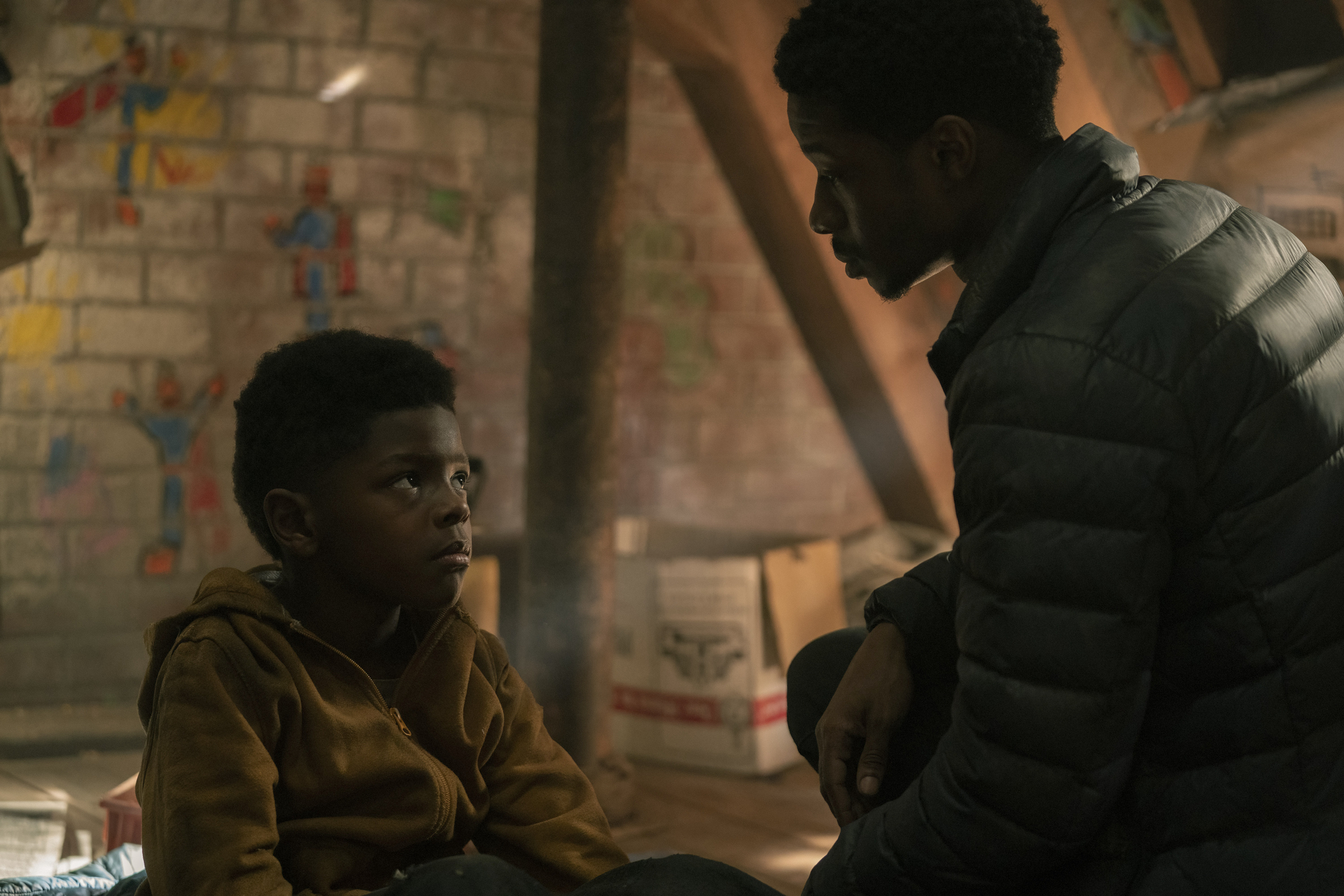
In this instance, it does this by flashing back to ten days earlier, so we not only learn about how Kathleen took power, but we get a full explanation of various aspects of the previous episode, such as who Dr. Edelstein is, why the attic was covered in children’s drawings of superheroes, where all those cans of food came from, and even why Sam had paint on his face. The show routinely grants itself the freedom to break free from a linear timeline and is very good about offering intriguing mysteries and then following through on meticulous explanations. We see last episode’s laundromat shootout from an entirely different vantage point and context as a stunned Henry watches Joel take out several of the men who are looking for him. Lamar Johnson plays Henry’s desperation, guilt, and need for a hero beautifully. In Joel, he sees everything he needs and wants at that moment. He sees a savior.
Which brings us right up to the present, with Henry and Sam pointing guns at Joel and Ellie, who had just fallen asleep laughing at a dumb joke about diarrhea. After Henry convinces Joel to not kill them when they lower their guns (a promise he finds difficult to make because “threatening” is his default setting), he introduces himself. “I’m the most wanted man in Kansas City. Although right now? My guess is you’re running a close second.” The foursome sit in a darkened conference room, sharing food. It’s such a wonderfully unusual choice of location to stage several of the scenes in empty office buildings, which just gives a story like this a different flavor compared to the usual rundown industrial spaces or moldy old houses that tend to dominate. Because these buildings are more or less hermetically sealed and largely useless, they remain eerily intact, with little more than a layer of thick dust to indicate the strangeness of the setting. Ellie tries to make friends and keeps pushing Joel to join in, but he announces that he’d like to move on. Henry tells him he can guide him out of the city. The next morning they survey the landscape, which Henry calls “Kill City.” He tells Joel that FEDRA had been pushed out of the city ten days ago and affirms that everything Joel heard about the KC FEDRA was that they were monsters and killers. Interesting to see that information still travels around the country and/or that Joel, as a smuggler, would be privy to all sorts of underground information. According to Henry, FEDRA raped and murdered and tortured the people of Kansas City for twenty years, which explains the brutality of the opening scenes and muddies the moral waters, making a lot of Kathleen’s actions a bit more understandable. Henry guiltily admits that he’s a collaborator. “I don’t work with rats,” Joel protests. “Yeah, you fucking do,” Sam counters. He knows the city and can get them out, but he doesn’t have the skills to make it through alive, admitting that he’d never killed anyone. “I show the way, you clear the way.”
His plan is to go through the tunnels connecting a series of buildings, some of which lie outside the perimeter being guarded by the militia members. The reason they can’t see any infected wandering the streets is because FEDRA drove them all underground ten years ago, which explains why KC seems fairly safe (aside from the people, that is) and also explains what was going on with that collapsed, shifting floor that Kathleen and Perry discovered last episode. Henry assures them that one of his FEDRA contacts told him that the tunnels are empty now, although Joel has a hard time believing that. As they enter the tunnels, Joel tells Ellie to get her gun out and the girl practically floats to the ceiling on a cloud of pride, offering Henry and Sam a slight smirk as she pulls it out. They travel through long, dark, empty tunnels until they come upon a door surrounded by childlike artwork of castles and rainbows. If you pay attention, you’ll see that the art direction on the show often returns to rainbows, flowers and butterflies in its imagery. It’s intensely poignant. Sam is delighted and rushes forward, but Joel, ever the protective father at heart, pushes him back. They enter a room that looks more or less like an underground daycare center. Joel talks about having heard of people who went underground on “outbreak day” and tried to form communities away from the devastation and infection. They opt to hang out there for a while until it gets darker. Sam and Ellie bond over their shared love of a comic book. He teaches her the signs for “Endure and survive,” evidently the hero’s stock phrase. Joel tells Henry that he’s sorry for calling him a rat earlier and he can see that he probably did what he did for his brother’s sake, adding that he thinks it’s cruel to send a whole army after him for that. Henry reveals that his crime was a pretty bad one. He turned in Kathleen’s brother Michael to FEDRA. Michael was the leader of the resistance movement and considered not just a great man by his people, but practically Messianic in his perfection. Never afraid, never selfish, always forgiving, according to Henry. “The kind of man you’d follow anywhere.” Sam had leukemia and Henry did what he had to in order to get him medication, which is one of the first times the show probably didn’t offer as much information as it could have. It seems pretty unlikely that his leukemia could have been put in remission or cured with just some old pills, but Henry doesn’t act like someone whose brother is dying. “I am the bad guy because I did a bad guy thing,” he tells Joel, adding that he figures Joel understands on some level. “You may not be her father, but you were someone’s.”
Kathleen is hanging out in her childhood bedroom when Perry comes to check on her and tell her that they haven’t found Henry or his accomplice yet. She’s melancholy and talks about her brother with the utmost reverence. He was clearly a beloved, exalted person and the episode does a really good job of using the absence of him to fuel the story. “He was so beautiful,” she laments, quietly adding “I’m not.” It’s interesting to wonder if this man really was as morally pure as everyone says, given how much the show sells the theme of everyone’s moral grayness. Is it possible everyone is just a little delusional about his memory? Melanie Lynskey is wonderful in this scene and while you can’t ignore the ways in which she was pretty monstrous throughout the story, she really sells how wronged Kathleen was and how much it’s broken her. “He would be horrified by things I’ve done,” she admits, one of several instances where she exhibits a highly refined ability for self-appraisal. She reveals that the last time she saw her brother in jail, he pleaded with her to forgive Henry for betraying him.Kathleen scoffs at the idea of forgiving. “Where is the justice in that?” she demands angrily. Perry noted that her brother was a great man, but he didn’t change anything, the first indication that everyone might be exalting his memory a bit too much. He reminds her that she did what her brother couldn’t. “We’re with you.”
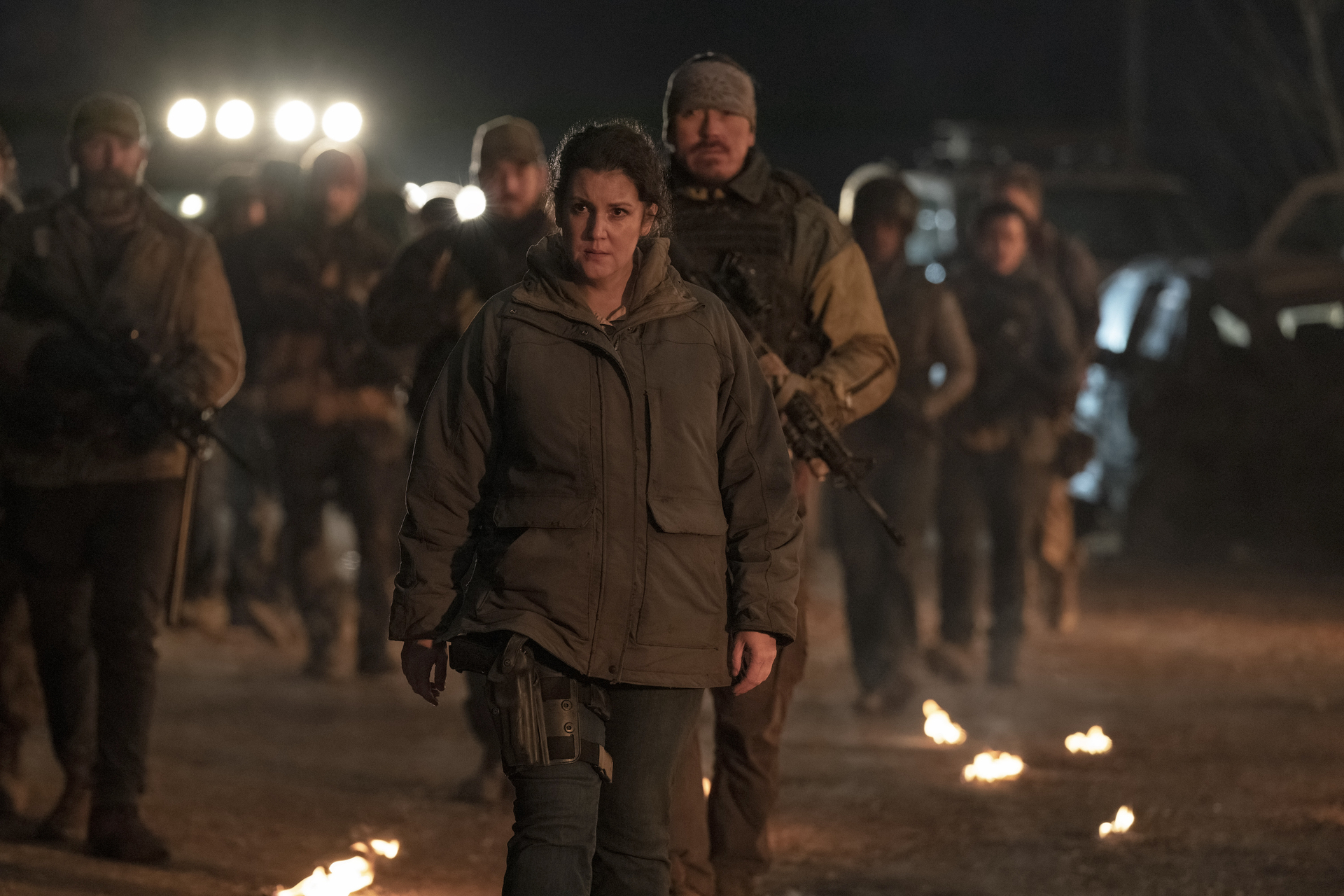
As we discussed in today’s podcast, Melanie Lynskey, in response to a jackass’s attempt to body shame her for being cast in this part, wrote a wonderful tweet thread explaining why Kathleen is such a fascinating character for her to play and why she thinks the show’s writers Craig Mazin and Neil Druckmann are brilliant for creating her. You can read it here, but the upshot is that Kathleen is in the position she’s in because she’s the smartest, most organized person in the room; the kind of person who makes lists, knows where everything is, and always has a notepad with her. In another life, Kathleen might have been a community organizer or politician. The fact of her hold over her people isn’t remotely hard to understand, but it really is a wonderfully counter-intuitive choice of casting for a character like this. As it did with the characters of Bill and Frank, who made an oasis out of their love for one another, The Last of Us is going out of its way to show you a different take on the kinds of people who might wind up thriving at the end of the world. Unlike Bill and Frank, however, Kathleen’s story winds up a purely tragic one, with devastating results for the people she fought so hard to free from their captivity.
Joel, Ellie, Henry and Sam exit the tunnels exactly where Henry said they would, in a deserted residential area outside the city. Unfortunately, they underestimated how well-prepared Kathleen is, and they are fired upon by a lone sniper. Joel sneaks into the man’s house and confronts him. He’s elderly; exactly the right person for this kind of job, which requires nothing more than sitting, watching and aiming. Kathleen knows what she’s doing. And he’s a very loyal soldier, willing to die trying to take Joel out rather than surrender. Joel begs him not to make him do it; two men who believe they’re making the moral choice, hoping that the other one will make the smart one. Joel kills the old man, hears that Kathleen and her troops are coming, and screams at the kids to run.
In this world, your choices in life, or the forces that shove you into situations where you have no choice at all, may wind up placing you behind the wheel of a massive truck as you try to run down fleeing children, secure in the knowledge that you’re doing the right thing for your community. The setup for what’s about to unfold is flawless. Joel shoots the driver of the truck, which careens into a nearby building and explodes. Meanwhile, Kathleen orders Henry to come out because he’s reached a dead end. She knows she has him cornered and she starts getting a little too confident about it.”That’s alright, it doesn’t matter,” she says with faux kindness when he fails to appear. He offers to come out if she’ll let the kids go. “No, sorry,” she replies, in the same tone someone would ask a waiter to return an order to the kitchen. She reveals that she knows exactly why he ratted her brother out. “Did you ever stop to think that maybe he was supposed to die?” she asks coldly, then adds (hilariously, thanks to Lynskey’s delivery) “Kids die, Henry. They die all the time.” It’s a horrible thing to say, but despite her next-door-neighbor demeanor, she’s almost certainly correct that they live in a world with an unimaginably high juvenile mortality rate. Twenty years of that is going to make a lot of people shrug at things we would consider monstrous. It’s sort of the flip side of Ellie’s perspective: pure wonder at all of the things we find mundane.
For a moment, Kathleen softens at the sight of Henry when he reveals himself, seemingly sorry that it came to this, but not really. “It ends how it ends,” she says with resignation as she aims her gun at him. But of course it doesn’t end the way she thought it would end because the explosion from the crashed truck must have blown open someone’s basement or sewer line and all of those infected who were shoved underground by FEDRA come flying out of the hole, including a gigantic “bloater” infected, completely covered in fungal armor, wholly stripped of any resemblance to the person it once was, and evidently nearly impossible to kill. What follows is one of the most intense action set pieces seen on television since the “Hardhome” or “Battle of the Bastards” episodes of Game of Thrones. Director Jeremy Webb does an amazing job of staging multiple planes of action in the chaos and using the editing to create little scenarios or stories in the middle of all of the action.
We see Joel protecting the kids from his perch by picking off every infected around them. There’s an almost psychic connection between Joel and Ellie as they’re able to communicate wordlessly across a distance. He provides cover for her as she attempts hide inside a car, watching helplessly while she fends off an infected clicker child with a cauliflower head. As the Bloater lumbers toward them, Perry tells Kathleen to run, find cover and don’t look back, then promptly gets his head torn off. Ellie has graduated to the upper levels of badassery, taking out two Clickers with a knife, saving Henry and Sam. Kathleen, maniacally single-minded at this point, tries to prevent Henry from leaving and is attacked by the cauliflower girl. The would-be child-killer, killed by a child.
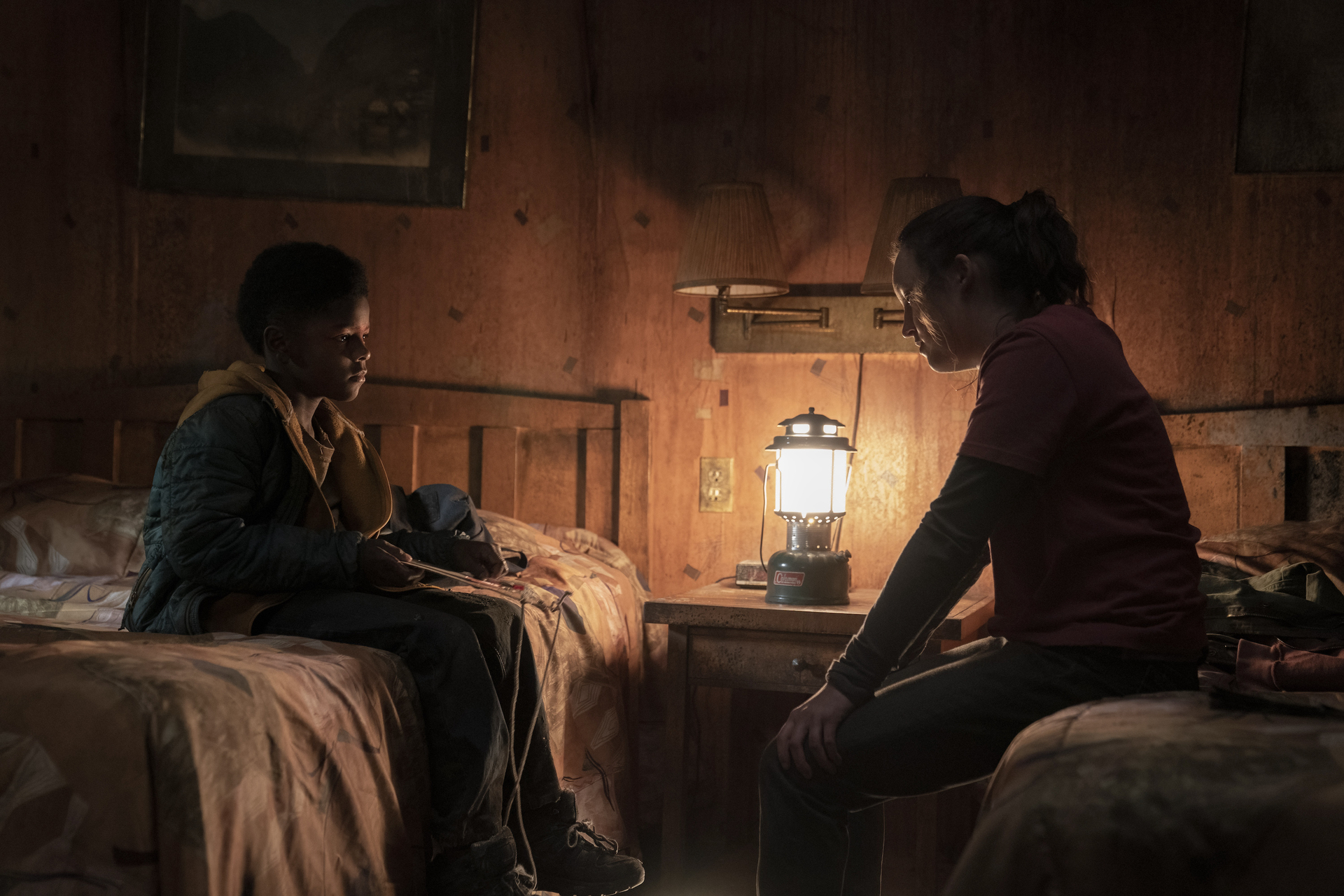
We can’t see Kathleen as a straight-up villain, but there’s no denying that her broken psyche and rage sent her on a single-minded pursuit that left a good chunk of her army dead and Kansas City completely exposed to a hoard of infected. There’s a very good chance that all of her hard work, her good work, will be undone by her mistakes. Worst of all, she turned out to be successful in her pursuit of vengeance. The group escapes and hole up in an old motel. Henry notes that Ellie seems okay and Joel notes that he thinks it’s easier for kids to bounce back from scenes like that because “they don’t have anyone relying on them. That’s the hard part.” Further taking on the fatherhood mantle that has been thrust on him, Joel invites Henry to come along with them to Wyoming. Henry can barely hide his gratitude and eagerness. He’s so desperate for a father figure to save him, it’s downright painful.
And speaking of painful, what follows is easily one of the most emotionally devastating sequences in a show that’s already made a name for itself for delivering them. While Bill and Frank’s story provoked a lot of tears, it was, as we vehemently argued, a happy ending for them. What happens to Sam and Henry is just heart-wrenching and the pacing of the show made it feel like a guillotine blade came down on you in the last few minutes. Ellie and Sam spent the episode bonding in that desperate way that refugee children with no friends would. How many options did these kids ever have to play? As it did with Tess, the show dangles the possibility of an enriching familial relationship for Ellie, and then rips it away from her. The tragedy of childish hope in a hopeless situation, as Ellie tries to make her blood into a magic potion that will save her new friend. The desperation for friendship, the fear that she’ll be left alone, his wondering if the infected are still people under all the mushrooms. Tragic beyond tragic. Then the sun comes up and all hell breaks loose. It happens so fast. Lamar Johnson breaks your heart into a million pieces. “What have I done?” In the end, Kathleen accomplished what she set out to do. She killed Henry and Sam. And finally, the devastating grace note, as Ellie, losing yet another possible friend, leaves the “I’m sorry” note on his grave. On top of everything else, she carries a guilt she shouldn’t have to carry. “Which way is west?” she asks Joel flatly. This show has an astonishing record when it comes to introducing characters and getting you to grieve for them an hour after you met them.
Michael B. Jordan in Ralph Lauren at the CREED III Mexico City Premiere Next Post:
RUPAUL’S DRAG RACE: The Daytona Wind 2
Please review our Community Guidelines before posting a comment. Thank you!

